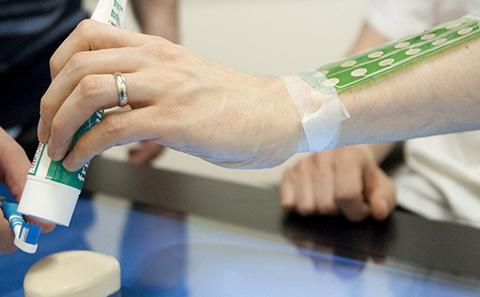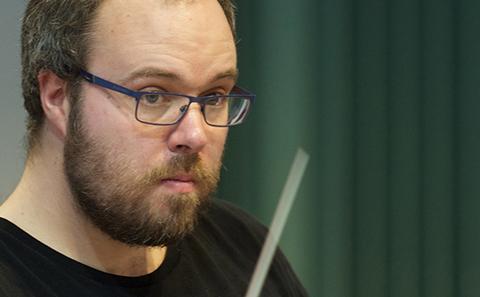Personalised sensors for medical tests
Paper-based sensors could test for multiple conditions without the need to visit the doctor.
Personalised sensors for medical tests
Paper-based sensors could test for multiple conditions without the need to visit the doctor.
Sensors play a vital role in monitoring the integrity of large structures such as buildings, transport and utilities infrastructure, as well as safeguarding our wellbeing at home by detecting smoke and dangerous gases such as carbon monoxide. However, an equally important application of sensors is to diagnose a range of medical conditions, enabling patients to manage their healthcare at home.
Southampton researchers are developing cheap, paper-based sensors to test for multiple conditions, and show the level of severity of each condition, all on a single test strip. Costing only a few pence to produce and printable in seconds, the paper sensors could be used across the world, particularly in remote settings where it is difficult to provide routine access to medical care.
The research team, whose members are Professor Rob Eason, Dr Collin Sones, Dr Ioannis Katis and Dr Peijun He in the University’s Optoelectronics Research Centre, are developing the paper-based sensors. They are part of Sensors@Southampton, a network of research teams from across the University that share ideas and expertise to advance the science of sensors.
Global sensor market
“With over seven billion people in the world, medical sensors are a global market,” says Rob. “Take the familiar pregnancy test; hundreds of millions are sold around the world every year and provide the user with a rapid ‘yes’ or ‘no’ answer to a very important question.
What if we could make a more versatile test that could detect a range of life-threatening diseases such as TB, HIV and hepatitis, plus other health problems such as high cholesterol, at the same time, on just one single test strip? This would help both in the developed and developing world.
To make the sensors, the researchers use lasers to create multiple flow channels into paper strips. They first deposit a monomer (a small subunit of an organic compound that, on activation from light, reacts with other monomers to form a larger molecule called a polymer) at the required location on the sensor. Using a laser, sections of the monomer are converted into a stable polymer. This process defines tiny flow channels on the paper that can be as narrow as 100 microns – the width of a human hair. Rob explains that a single paper sensor could have tens of separate flow channels on it, each one testing for a different condition, using the same type of colorimetric indicator mechanism as a pregnancy test.
Detecting severity
“Not only could you test for multiple conditions with one sample of urine or blood plasma, but you could also test for the severity of a condition,” says Rob. “For example, in a multiple test strip, the colour change observed can indicate whether the disease or condition is present in a mild, moderate, severe or critical level and therefore what the patient or clinician’s next actions need to be,” he adds.
Working with Professor Paul Elkington, Professor in Respiratory Medicine, and other colleagues, Rob and the team are currently developing a paper-based test for TB. “Although TB is traditionally thought to have been prevalent only in the past, in some countries, including India, it is responsible for approximately two million deaths per year. And in the UK it is making a comeback, with parts of London having higher rates than Rwanda or Iraq.
“As well as the active form, there is also a latent form of TB, where a person has the disease, but no symptoms. This can then develop into active TB at a later date. We are looking at creating a sensor that can detect this latent form, and also quantify its level of severity,” says Rob.
Versatile technology
The team’s sensor technology could test for other diseases such as MRSA and Clostridium difficile in hospitals, and infectious diseases at home, to minimise the spread of infection, explains Rob. “Detecting some diseases, such as TB or possibly sexually transmitted infections (STIs) at home does raise important issues around a person’s reaction to a positive result,” he says. “However, we could make our paper test in such a way that the result is encoded. The user would then scan the result using a smartphone, send it to their health centre where the diagnosis could be made, and the user would then receive the support they need to deal with the outcome.”
The versatile technology is also applicable in other industries, such as veterinary science. In the UK, foot and mouth disease periodically arises, threatening the entire cattle population. Farmers could use a paper sensor to diagnose the disease immediately and send the results to the authorities, enabling them to rapidly isolate the infection before it has a chance to spread, explains Rob. “The use of smartphones coupled with our test would be vital to inform the government about the location of the outbreak, and provide information on whether the disease was spreading and how to best contain it.”
Medical tests for all
The researchers are in the process of creating a spin-out company to manufacture the paper sensors. They have also had discussions with more than 70 companies to establish the optimum route to commercialise a whole host of medical sensors.
Several large global diagnostic companies have expressed an interest in our technology and are keen to work with us on developing a range of sensors. Our paper-based platform, combined with their biochemical expertise and regulatory approval, could open up the possibility of rapid, cost-effective and mass-distributable medical tests available for all.
Find out more about this research.
Related staff members
You may also be interested in:

Tackling the prevalence of diabetes
Leading research linking diabetes and mental health

Enabling stroke rehabilitation
Southampton researchers are developing innovative solutions to help people recover from stroke.

Enjoying music with a cochlear implant
Interdisciplinary Southampton team helps cochlear implant users to appreciate music.